 |
 |
|
 |
Gov. Pawlenty hails agreement with railway for Northstar commuter rail project |
 |
 |
Calling it a major milestone in the development of the Northstar project, Gov. Tim Pawlenty announced an agreement in principle with the Burlington Northern Santa Fe Railroad on financial terms for construction and general operation of the commuter rail line from Big Lake to Minneapolis.
The agreement includes the railroad, the state and the Northstar Corridor Development Authority, which also includes officials from counties along the proposed route.It will allow Northstar commuter rail trains to run on the railroad company's track between Minneapolis and Big Lake.
"This is a huge success," said Bob McFarlin, assistant to Lt. Gov. and Transportation Commissioner Carol Molnau. "Until today's announcement, we were sitting across the table from BNSF. Now we have a common vision on how this project can work."
Mike Schadauer, Northstar Project Office, agreed.He said the agreement with the railroad represents one of the most significant steps in the process to build the commuter rail line.
"This gives us momentum to get bonding for the project approved and to keep the project moving," he said.
For more information about the agreement go to: mndot.gov .
|
back

|
 |
Dedications, remembrances mark Workers Memorial Day |
 |
 |
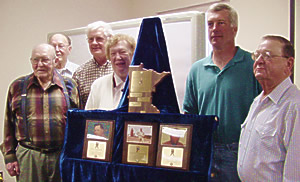 |
|
Friends, family and former co-workers of Roy Johnson attended the dedication in Crookston. Those in attendance include (from left) Phil Ryberg; Pete Craigmile; Eldon Johnson, a cousin of Johnson; Audrey Johnson (Johnson’s widow); Keith Johnson, a transportation generalist at the district’s Hallock truck station, and Don Nordling. Ryberg, Craigmile and Nordling are Mn/DOT retirees. Photo by Karen Bedeau |
Employees at Bemidji/District 2 dedicated plaques at Bemidji and Crookston to honor three district employees who died working on the state’s highways.
Plaque dedications created lasting tributes to Merlin Fugleberg, Thief River Falls resident office; Alan Johnson, Karlstad truck station, and Roy Johnson of the Hallock truck station. Fugleberg died in 1968; Alan Johnson and Roy Johnson both died in 1979.
Observances similar to District 2’s were held throughout the department April 28, Workers Memorial Day.
A message from Lt..Gov/Commissioner Carol Molnau was played as employees shared a moment of silence to honor those killed or injured in the line of duty.
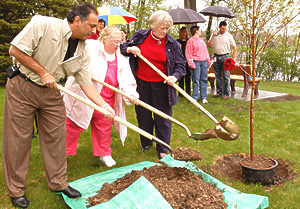 |
Vicky Stary, (middle), the widow of Ed Stary, joined Khani Sahebjam, Metro District engineer, and Lt. Gov./Commissioner Carol Molnau to plant a tree that will memorialize Mn/DOT employees who were killed or injured on the job. Ed Stary, a deceased Metro District employee, died in a job-related vehicle crash in 2004. Photo by David Gonzalez |
Molnau also spoke with employees at the Metro District headquarters in Roseville during an observance there.
She thanked Mn/DOT employees for their service and urged motorists to use extreme care while driving in highway work zones.
Since 1960, 29 Mn/DOT employees have died on the job.
At Mankato/District 7, employees shared a lunch that honored their fellow union members with construction workers at a new power plant site in Mankato.
At District 6, Mn/DOT, union and community leaders spoke during observances at Owatonna and Rochester.
In Rochester, Ken DeCramer, an engineering specialist, recalled being struck by a pick-up truck in 1989 when he was working on a survey crew. He suffered serious injuries from the crash.
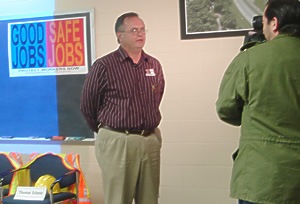 |
Ken DeCramer, who was struck by a pick-up truck in 1989, recounted his experiences during a news media interview at Rochester. Photo by Kristine Hernandez |
“I was lucky; I had co-workers who had first aid training who were able to take care of me until the ambulance arrived,” DeCramer said. “It’s easy for accidents to happen. They can end somebody’s life or permanently injure them.”
By Craig Wilkins
|
back

|
 |
Mn/DOT wins two 2006 FHWA awards for excellence |
 |
 |
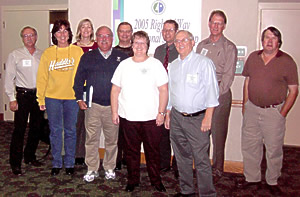 |
Right-of-way workshop committee members who shared the award include (front, from left), Lisa Beckman, SRF, Inc.; Kurt Hartner, Yaggy Colby Associates; Samantha Juneau, Metro District, and Mike Stensburg, assistant director, OLM. (Back row, from left) Mike Moran, OLM; Cheryl Hunstock, OLM; Mike Kelly, Anoka County; Karl Rasmussen, state right-of-way engineer; Don Mueting, Attorney General’s Office, and Paul Gustafson, OLM. Mn/DOT photo |
Mn/DOT earned two FHWA Excellence Awards at the 2006 AASHTO Right of Way and Utilities Subcommittee meeting May 1 in Baltimore.
Al Pint, Office of Land Management director, and Marilyn Remer, Technical Support, accepted the awards for Mn/DOT.
The first is an Excellence in Right-of-Way Stewardship Award for the 2005 Right-of-Way Professionals Workshop.
The second is an Excellence in Utility Relocation and Accommodation Award. It honors Mn/DOT’s Utility Manual Accommodation Policy Rewrite and Training Delivery Project.
The Office of Land Management has hosted an annual workshop for right-of-way professionals for the past 13 years. The 2005 workshop included topics of interest to about 300 government and private sector practitioners who acquire property for transportation projects. This is the only event of this kind held in Minnesota.
“We wanted the 2005 workshop to offer topics of value to both public and private sector employees,” Pint said. “We have really come to appreciate the contributions made by our public and private sector partners.”
The workshop was tailored for appraisers, real estate professionals, attorneys and engineers.
“The planning team worked hard to develop a workshop that helped participants maximize their learning experiences,” Pint said.
The second award recognized a joint effort to develop a new utility coordination process that will minimize project delays, construction costs and contractor claims while increasing the number of utility relocations that can be done before construction work begins.
This year’s subcommittee meeting was the first where its members formally recognized efforts in the utility relocation process, said Marilyn Remer, manager of the Utilities, Agreements and Permits Unit in the Office of Technical Support.
Staff from Mn/DOT, the Center for Transportation Studies and consulting firms developed the process.
“This process builds on an existing process to strengthen communications and collaboration between all parties whose work impacts utility coordination,” Remer said “The goal is to limit unexpected utility issues that occur late in a transportation project’s design or construction that can result in extra cost, time and effort.”
Mn/DOT has started using this process by holding five training sessions with internal staff, utilities, municipalities and consultants. More sessions are planned, she said.
“By the spring of 2007, we expect to use the new process on all of our projects,” Remer said.
For more information about the stewardship award, contact Cheryl Hunstock, training coordinator, OLM, 651/297-7168. For information about the utility process, contact Remer, 651/296-7018.
By Donna Lindberg
|
back

|
 |
Bemidji District workers burn debris to open flood-choked roads |
 |
 |
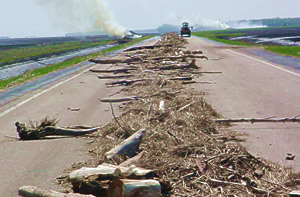 |
|
Maintenance crews burn piles of debris left by floodwaters on Hwy 220 near Oslo in Marshall County. District 2 officials expect currently closed roads will be open by May 20. Photo by Dave Dalager |
After the flood—the fire.
Maintenance crews in the Bemidji District are burning piles of debris left by floodwaters on two highways in order to reopen them to traffic.
Dave Dalager, maintenance superintendent at Crookston, said he expects the roads will be fully passable by May 20, about six weeks after extensive flooding first closed them.
The routes still closed are Hwy 220 from Hwy 1 to Hwy 11 and Hwy 317 from the North Dakota state line to Hwy 220.
Maintenance crews push the lighter debris onto the highway centerline, then ignite it. When the fires become more intense, they add large tree limbs and trunks to the blaze.
Dalager said getting the last of the flooded roads open won’t take quite as long as during the floods of 1997. The three sections, he said, have been closed for about six weeks. Some highways that year, he said, were closed for seven or eight weeks.
He said, however, that damage from the flooding will be far less extensive than in 1997.
“The amount of damage we have up here is truly amazing given how long the roads were under water and how much water activity we had from high winds,” Dalager said.
District officials have estimated damage at about $250,000.
Preventive action taken since the devastating 1997 floods, he said, helped reduce the extent and level of damage to the highway system.
"The experience we had in 1997 that led us to pave shoulders and in-slopes to a width of three to four feet really helped save our bacon up here,” Dalager said.
By Craig Wilkins
|
back

|
 |
Interstate system designers go ‘underground’ to deal with highway drainage issues, slippery soil conditions |
 |
 |
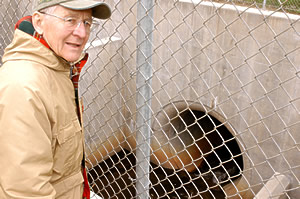 |
|
Floyd Laumann revisits a storm drain inlet site near Hwy 5 that is part of the drainage system for a section of I-494 and the Minneapolis-St. Paul International Airport. He was an hydraulics engineer on the project. Photo by David Gonzalez |
Not everything there is about an interstate highway meets the traveler’s eye.
This month’s article about the 50th anniversary of the Interstate Highway System explores things that work underground.
There are, for example, drainage systems.
Floyd Laumann, a retired engineer, said Mn/DOT assembled its experts in building drainage systems into the Hydraulics Unit in 1957.
Unit members devised ways to drain areas such as Interstate 494 in Bloomington and the adjacent Minneapolis-St. Paul International Airport.
They used straw bales to distribute the weight of fill needed cover a huge drainage pipe and built a stilling basin to reduce the speed and force of drain water as it entered the Minnesota River.
They also took on building drainage systems for I-90 in the environmentally sensitive hill region of southeastern Minnesota.
Mn/DOT engineers also faced challenges such as the high bluffs over I-35E in St. Paul that contain a deep seam of bentonite, a unstable, clay-like soil.
Jack Pirkl, now a Metro District maintenance operations engineer, was as a project engineer during construction of the once highly controversial I-35E Parkway.
Engineers, he said, designed method to prevent movement in the bluff and the ground under the pavement by sinking a series of concrete caissons deep into the hard rock in the bluff area.
The caissons held the bluffs in place and prevented further instability in the freeway corridor below them.
To read more about these projects and the people who built them, visit Mn/DOT’s 50 th anniversary of the interstate highway system Web site: http://www.dot.state.mn.us/interstate50/ .
|
back

|
 |
|
 |



